Evolution of the Relationship between Runoff and Sediment Transport during Flood Event in the Chabagou Watershed of the Loess Plateau
Abstract
:1. Introduction
2. Materials and Methods
2.1. Site Description
2.2. Data Sources
2.3. Methods
2.3.1. Sediment Yield (SY)
2.3.2. Rainfall Erosivity (RE)
2.3.3. Runoff Erosion Power (REP)
2.3.4. Elastic Coefficient
3. Results
3.1. Characteristics of RA and SY in Both Periods
3.2. Characteristics of Peak Flow in Both Periods
3.3. Relationship between Runoff Process and Sediment Transport in Both Periods
4. Discussion
4.1. Influence of Precipitation Related Indices on Hydrological Factors
4.2. Effects of Erosion Dynamics on Sediment Delivery Modulus
4.3. Effects of Conservation Measures on Sediment Yield
5. Conclusions
- (1)
- In comparison to PD-I, the P of flood event rose by 62.2% in PD-II, RA increased by 86.1%, but SY fell by 48.3%. When PF was less than 50 m3 s−1, the number of flood events in both periods was highest, the fraction of SY was lowest, and the average value of SDM was the lowest. When PF was higher than 200 m3 s−1, the frequency of flood events in both periods was the least and the average value of SDM was the highest. 8.9% of flood events in PD-I added 38.8% of sediment yield, and 4.4% of flood events in PD-II added 30.8% to the sediment yield.
- (2)
- In the two-period linear relationship, the SY of flood events went up with RA. As a power function relationship, SC grew with PF during both periods. When PF in PD-I was less than 50 m3 s−1, SC went up rapidly; but when PF was higher than 200 m3 s−1, the increasing rate of SC gradually slowed down and the sediment concentration growth also reduced. In PD-II, SC increased with the increase of PF, and the increasing rate of SC was relatively stable. SY was more sensitive to P of the flood event than rainfall intensity (RI), and the sensitivity of RA and SY to P in PD-II was greater than that in PD-I.
- (3)
- The SDM of flood events rose linearly with RE in both periods, and was power function relationship with REP. Under these two relationships, the increasing rate of SDM in PD-II was clearly less than that in PD-I, and the SDM distribution was more concentrated in PD-I, with the characteristic of “concentrate on high value and disperse at low value”.
- (4)
- The improvement of the underlying surface not only raised the threshold of RA corresponding with peak SC, but also shortened the duration of high sediment concentration and lowered the sediment transportation capacity.
Author Contributions
Funding
Institutional Review Board Statement
Informed Consent Statement
Data Availability Statement
Acknowledgments
Conflicts of Interest
References
- González-Lemos, S.; Jiménez-Sánchez, M.; Stoll, H.M. Sediment transport during recent cave flooding events and characterization of speleothem archives of past flooding. Geomorphology 2015, 228, 87–100. [Google Scholar] [CrossRef]
- Ochoa, P.A.; Fries, A.; Mejía, D.; Burneo, J.I.; Ruíz-Sinoga, J.D.; Cerdà, A. Effects of Climate, Land Cover and Topography on Soil Erosion Risk in a Semiarid Basin of the Andes. Catena 2016, 140, 31–42. [Google Scholar] [CrossRef]
- Prokešová, R.; Horáčková, Š.; Snopková, Z. Surface runoff response to long-term land use changes: Spatial rearrangement of runoff-generating areas reveals a shift in flash flood drivers. Sci. Total Environ. 2022, 815, 151591. [Google Scholar] [CrossRef] [PubMed]
- Boardman, J. Soil Erosion and Flooding on the Eastern South Downs, Southern England, 1976-2001. Trans. Inst. Br. Geogr. 2003, 28, 176–196. [Google Scholar] [CrossRef]
- Fan, X.; Shi, C.; Shao, W.; Zhou, Y. The Suspended Sediment Dynamics in the Inner-Mongolia Reaches of the Upper Yellow River. Catena 2013, 109, 72–82. [Google Scholar] [CrossRef]
- Wang, Y.; Wang, S.; Wang, C.; Zhao, W. Runoff Sensitivity Increases with Land Use/Cover Change Contributing to Runoff Decline across the Middle Reaches of the Yellow River Basin. J. Hydrol. 2021, 600, 126536. [Google Scholar] [CrossRef]
- Buendia, C.; Bussi, G.; Tuset, J.; Vericat, D.; Sabater, S.; Palau, A.; Batalla, R.J. Effects of Afforestation on Runoff and Sediment Load in an Upland Mediterranean Catchment. Sci. Total Environ. 2016, 540, 144–157. [Google Scholar] [CrossRef]
- He, Y.; Wang, F.; Mu, X.; Guo, L.; Gao, P.; Zhao, G. Human Activity and Climate Variability Impacts on Sediment Discharge and Runoff in the Yellow River of China. Theor. Appl. Climatol. 2017, 129, 645–654. [Google Scholar] [CrossRef]
- Hu, C.; Zhang, S.; Zhang, X. Research on Water and Sediment Regulation of the Yellow River under New Situation. Eng. Sci. 2022, 24, 122–130. [Google Scholar] [CrossRef]
- Hu, C.; Zhang, X. Several Key Questions in the Researches of Runoff and Sediment Changes and Trend Predictions in the Yellow River. J. Hydraul. Eng. 2018, 49, 1028–1039. [Google Scholar]
- Li, L.; Ni, J.; Chang, F.; Yue, Y.; Frolova, N.; Magritsky, D.; Borthwick, A.G.L.; Ciais, P.; Wang, Y.; Zheng, C.; et al. Global Trends in Water and Sediment Fluxes of the World’s Large Rivers. Sci. Bull. 2020, 65, 62–69. [Google Scholar] [CrossRef] [Green Version]
- Shi, C.; Zhou, Y.; Fan, X.; Shao, W. A Study on the Annual Runoff Change and Its Relationship with Water and Soil Conservation Practices and Climate Change in the Middle Yellow River Basin. Catena 2013, 100, 31–41. [Google Scholar] [CrossRef]
- Liang, W.; Bai, D.; Wang, F.; Fu, B.; Yan, J.; Wang, S.; Yang, Y.; Long, D.; Feng, M. Quantifying the Impacts of Climate Change and Ecological Restoration on Streamflow Changes Based on a Budyko Hydrological Model in China’s Loess Plateau. Water Resour. Res. 2015, 51, 6500–6519. [Google Scholar] [CrossRef]
- Xu, X.; Yang, H.; Yang, D.; Ma, H. Assessing the Impacts of Climate Variability and Human Activities on Annual Runoff in the Luan River Basin, China. Hydrol. Res. 2013, 44, 940–952. [Google Scholar] [CrossRef]
- Tian, P.; Zhai, J.; Zhao, G.; Mu, X. Dynamics of Runoff and Suspended Sediment Transport in a Highly Erodible Catchment on the Chinese Loess Plateau. Land Degrad. Dev. 2016, 27, 839–850. [Google Scholar] [CrossRef]
- Rodrigo Comino, J.; Senciales, J.M.; Ramos, M.C.; Martínez-Casasnovas, J.A.; Lasanta, T.; Brevik, E.C.; Ries, J.B.; Ruiz Sinoga, J.D. Understanding Soil Erosion Processes in Mediterranean Sloping Vineyards (Montes de Málaga, Spain). Geoderma 2017, 296, 47–59. [Google Scholar] [CrossRef]
- Hu, J.; Zhao, G.; Mu, X.; Hörmann, G.; Tian, P.; Gao, P.; Sun, W. Effect of Soil and Water Conservation Measures on Regime-Based Suspended Sediment Load during Floods. Sustain. Cities Soc. 2020, 55, 102044. [Google Scholar] [CrossRef]
- Ran, Q.; Zong, X.; Ye, S.; Gao, J.; Hong, Y. Dominant Mechanism for Annual Maximum Flood and Sediment Events Generation in the Yellow River Basin. Catena 2020, 187, 104376. [Google Scholar] [CrossRef]
- An, J.; Zheng, F.L.; Han, Y. Effects of Rainstorm Patterns on Runoff and Sediment Yield Processes. Soil Sci. 2014, 179, 293–303. [Google Scholar] [CrossRef]
- Borga, M.; Stoffel, M.; Marchi, L.; Marra, F.; Jakob, M. Hydrogeomorphic Response to Extreme Rainfall in Headwater Systems: Flash Floods and Debris Flows. J. Hydrol. 2014, 518, 194–205. [Google Scholar] [CrossRef]
- Liu, J.H.; Wang, G.Q.; Li, H.H.; Gong, J.G.; Han, J.Y. Water and Sediment Evolution in Areas with High and Coarse Sediment Yield of the Loess Plateau. Int. J. Sediment Res. 2013, 28, 448–457. [Google Scholar] [CrossRef]
- Zeng, X.; Sun, K.; Wang, C.; An, C.; Lei, H.; Li, P.; Fu, X. Regulating Effect of Check Dams on Erosion Dynamics and Sediment Transport during Flooding. J. Tsinghua Univ. (Sci. Technol.) 2022, 2003–2005. [Google Scholar] [CrossRef]
- Gu, C.; Mu, X.; Sun, W.; Gao, P.; Zhao, G. Comparative Analysis of the Responses of Rainstorm Flood and Sediment Yield to Vegetation Rehabilitation in the Yanhe River Basin. J. Nat. Resour. 2017, 32, 1755–1767. [Google Scholar]
- Fu, S.; Yang, Y.; Liu, B.; Liu, H.; Liu, J.; Liu, L.; Li, P. Peak Flow Rate Response to Vegetation and Terraces under Extreme Rainstorms. Agric. Ecosyst. Environ. 2020, 288, 106714. [Google Scholar] [CrossRef]
- Mo, S.; Gong, Y.; Li, J.; Shen, B. Impact of Human Activities on Flood Process in Chabagou Basin of the Loess Plateau, China. J. Basic Sci. Eng. 2019, 27, 492–508. [Google Scholar]
- Yu, W.; Ding, W.; Liu, Y.; Kang, J.; Guo, Y. Runoff and Sediment Relationship in Chabagou Catchment Based on Sediment Dynamics in Typical Single Flood Event. J. Yangze River Sci. Res. Inst. 2020, 37, 20–26. [Google Scholar]
- Lu, K.; Li, Z.; Li, P.; Ju, H. Rediction of Watershed Sediment Transport for Single Rainstorm Based on Runoff Erosion Power. J. Yangze River Sci. Res. Inst. 2008, 25, 31–34. [Google Scholar]
- Zhang, L.T.; Li, Z.B.; Wang, H.; Xiao, J.B. Influence of Intra-Event-Based Flood Regime on Sediment Flow Behavior from a Typical Agro-Catchment of the Chinese Loess Plateau. J. Hydrol. 2016, 538, 71–81. [Google Scholar] [CrossRef]
- Wang, W.; Yin, S.; Yuan, Y. Comparison of Event and Daily Precipitations. J. Beijing Norm. Univ. (Nat. Sci.) 2018, 54, 224–231. [Google Scholar]
- Zhang, W.; Xie, Y.; Liu, B. Estimation of Rainfall Erosivity Using Rainfall Amount and Rainfall Intensity. Geogr. Res. 2002, 21, 384–390. [Google Scholar]
- Zhang, L.T.; Li, Z.B.; Wang, S.S. Spatial Scale Effect on Sediment Dynamics in Basin-Wide Floods within a Typical Agro-Watershed: A Case Study in the Hilly Loess Region of the Chinese Loess Plateau. Sci. Total Environ. 2016, 572, 476–486. [Google Scholar] [CrossRef] [PubMed]
- Sankarasubramanian, A.; Vogel, R.M.; Limbrunner, J.F. Climate Elasticity of Streamflow in the United States. Water Resour. Res. 2001, 37, 1771–1781. [Google Scholar] [CrossRef]
- Huang, M.; Zhang, L.; Gallichand, J. Runoff Responses to Afforestation in a Watershed of the Loess Plateau, China. Hydrol. Process. 2003, 17, 2599–2609. [Google Scholar] [CrossRef]
- Li, C.; Pan, C. The Relative Importance of Different Grass Components in Controlling Runoff and Erosion on a Hillslope under Simulated Rainfall. J. Hydrol. 2018, 558, 90–103. [Google Scholar] [CrossRef]
- Mu, H.; Yu, X.; Fu, S.; Yu, B.; Liu, Y.; Zhang, G. Effect of Stem Cover on Hydraulic Parameters of Overland Flow. J. Hydrol. 2019, 577, 123964. [Google Scholar] [CrossRef]
- Yuan, S.; Li, Z.; Chen, L.; Li, P.; Zhang, Z.; Zhang, J.; Wang, A.; Yu, K. Effects of a Check Dam System on the Runoff Generation and Concentration Processes of a Catchment on the Loess Plateau. Int. Soil Water Conserv. Res. 2022, 10, 86–98. [Google Scholar] [CrossRef]
- Liu, X.Y.; Wang, F.G.; Yang, S.T.; Li, X.Y.; Ma, H.B.; He, X.Z. Sediment Reduction Effect of Level Terrace in the Hilly-Gully Region in the Loess Plateau. Shuili Xuebao/J. Hydraul. Eng. 2014, 45, 793–800. [Google Scholar]
- Gao, Z.L.; Fu, Y.L.; Li, Y.H.; Liu, J.X.; Chen, N.; Zhang, X.P. Trends of Streamflow, Sediment Load and Their Dynamic Relation for the Catchments in the Middle Reaches of the Yellow River over the Past Five Decades. Hydrol. Earth Syst. Sci. 2012, 16, 3219–3231. [Google Scholar] [CrossRef] [Green Version]
- Shi, H.; Wang, G. Impacts of Climate Change and Hydraulic Structures on Runoff and Sediment Discharge in the Middle Yellow River. Hydrol. Process. 2015, 29, 3236–3246. [Google Scholar] [CrossRef]
- Chang, J.; Wei, J.; Wang, Y.; Yuan, M.; Guo, J. Precipitation and Runoff Variations in the Yellow River Basin of China. J. Hydroinformatics 2017, 19, 138–155. [Google Scholar] [CrossRef]
- Xue, F.; Zhang, X.; Zhang, L.; Liu, B.; Yang, Q.; Yi, H.; He, L.; Zou, Y.; He, J.; Xu, X.; et al. Attribution Recognition of Streamflow and Sediment Changes Based on the Budyko Hypothesis and Fractal Theory: A Case Study in the Beiluo River Basin. Acta Geogr. Sin. 2022, 77, 79–92. [Google Scholar]
- Nadal-Romero, E.; Regüés, D.; Latron, J. Relationships among rainfall, runoff, and suspended sediment in a small catchment with badlands. Catena 2008, 74, 127–136. [Google Scholar] [CrossRef]
- Li, S.; Wang, C.; Yan, J.; Liu, X. Variability of the Event-Based Extreme Precipitation in the South and North Qinling Mountains. Acta Geogr. Sin. 2020, 75, 989–1007. [Google Scholar]
- Li, P.; Xu, G.; Lu, K.; Zhang, X.; Shi, P.; Bai, L.; Ren, Z.; Pang, G.; Xiao, L.; Gao, H.; et al. Runoff Change and Sediment Source during Rainstorms in an Ecologically Constructed Watershed on the Loess Plateau, China. Sci. Total Environ. 2019, 664, 968–974. [Google Scholar] [CrossRef] [PubMed]
- Zhao, G.; Kondolf, G.M.; Mu, X.; Han, M.; He, Z.; Rubin, Z.; Wang, F.; Gao, P.; Sun, W. Sediment Yield Reduction Associated with Land Use Changes and Check Dams in a Catchment of the Loess Plateau, China. Catena 2017, 148, 126–137. [Google Scholar] [CrossRef]
- Liu, X.; Gao, Y.; Ma, S.; Dong, G. Sediment Reduction of Warping Dams and Its Timeliness in the Loess Plateau. J. Hydraul. Eng. 2018, 49, 145–155. [Google Scholar]
- Bai, L.; Wang, N.; Jiao, J.; Chen, Y.; Tang, B.; Wang, H.; Chen, Y.; Yan, X.; Wang, Z. Soil Erosion and Sediment Interception by Check Dams in a Watershed for an Extreme Rainstorm on the Loess Plateau, China. Int. J. Sediment Res. 2020, 35, 408–416. [Google Scholar] [CrossRef]
- Ran, Q.; Tang, H.; Wang, F.; Gao, J. Numerical Modelling Shows an Old Check-Dam Still Attenuates Flooding and Sediment Transport. Earth Surf. Process. Landforms 2021, 46, 1549–1567. [Google Scholar] [CrossRef]
- Yuan, S.; Li, Z.; Chen, L.; Li, P.; Zhang, Z. Influence of Check Dams on Flood Hydrology across Varying Stages of Their Lifespan in a Highly Erodible Catchment, Loess Plateau of China. Catena 2022, 210, 105864. [Google Scholar] [CrossRef]
- Wang, S.; Fu, B.; Piao, S.; Lü, Y.; Ciais, P.; Feng, X.; Wang, Y. Reduced Sediment Transport in the Yellow River Due to Anthropogenic Changes. Nat. Geosci. 2016, 9, 38–41. [Google Scholar] [CrossRef]
- Zhang, J.; Gao, G.; Fu, B.; Gupta, H.V. Formulating an Elasticity Approach to Quantify the Effects of Climate Variability and Ecological Restoration on Sediment Discharge Change in the Loess Plateau, China. Water Resour. Res. 2019, 55, 9604–9622. [Google Scholar] [CrossRef]
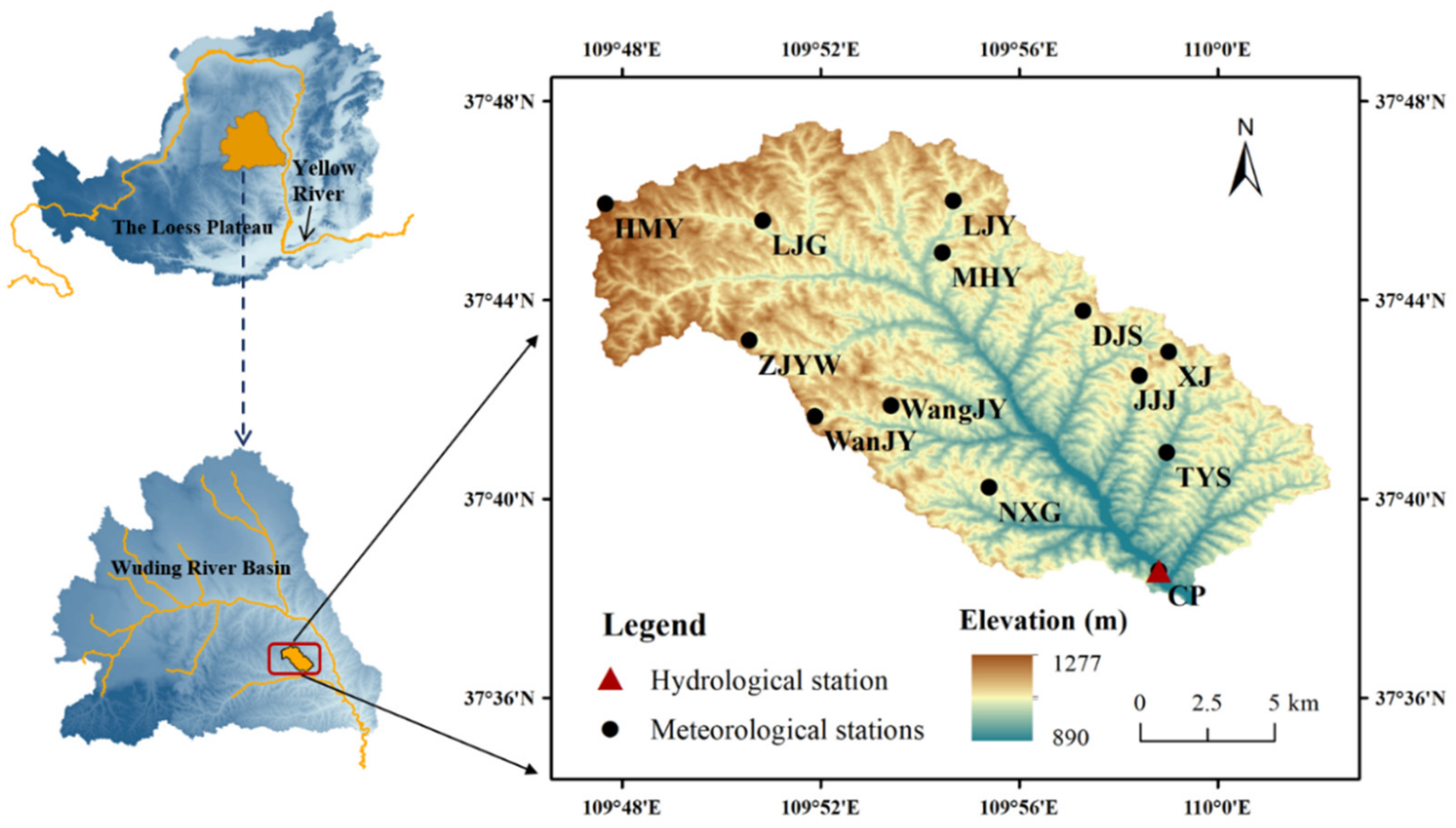

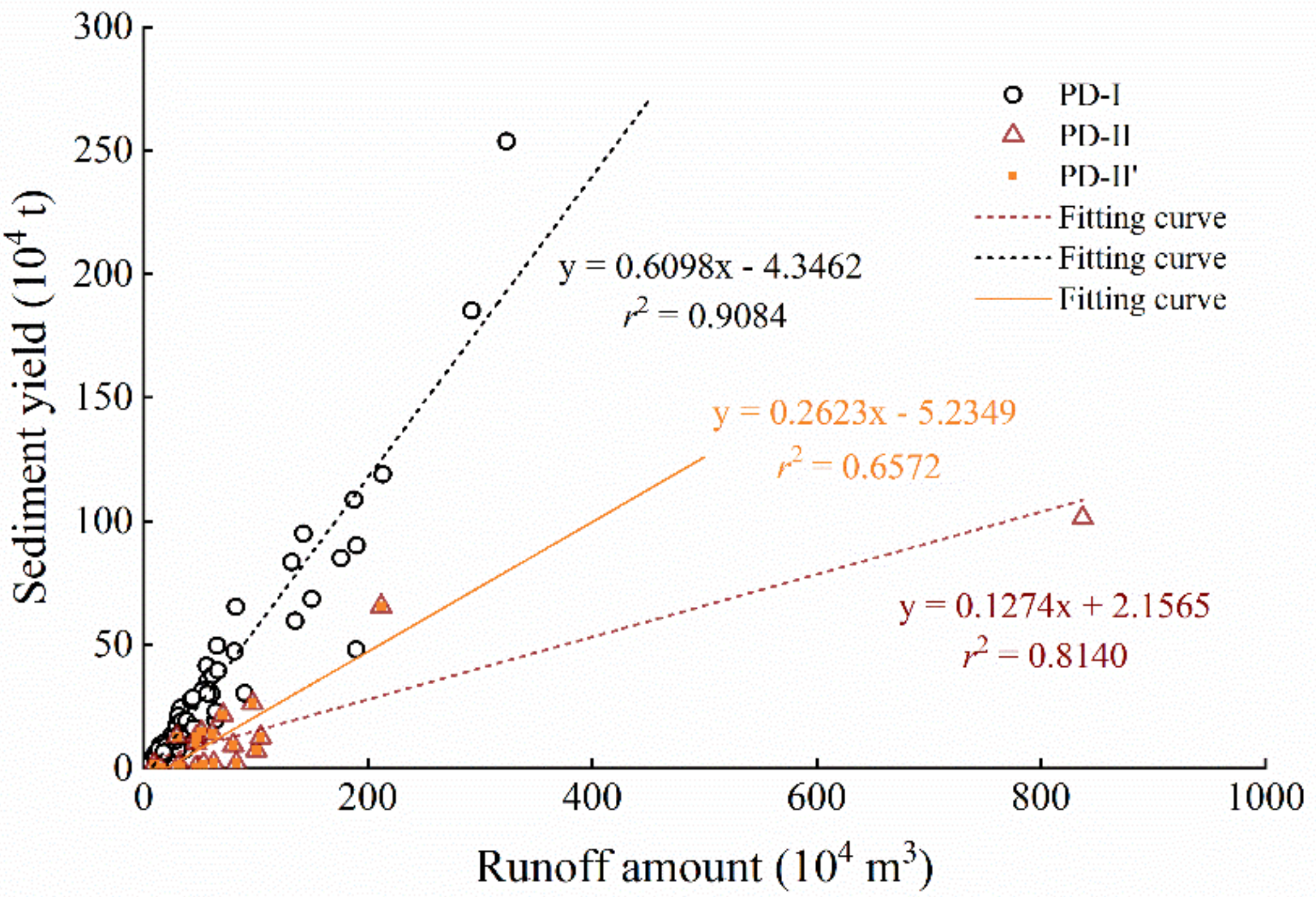

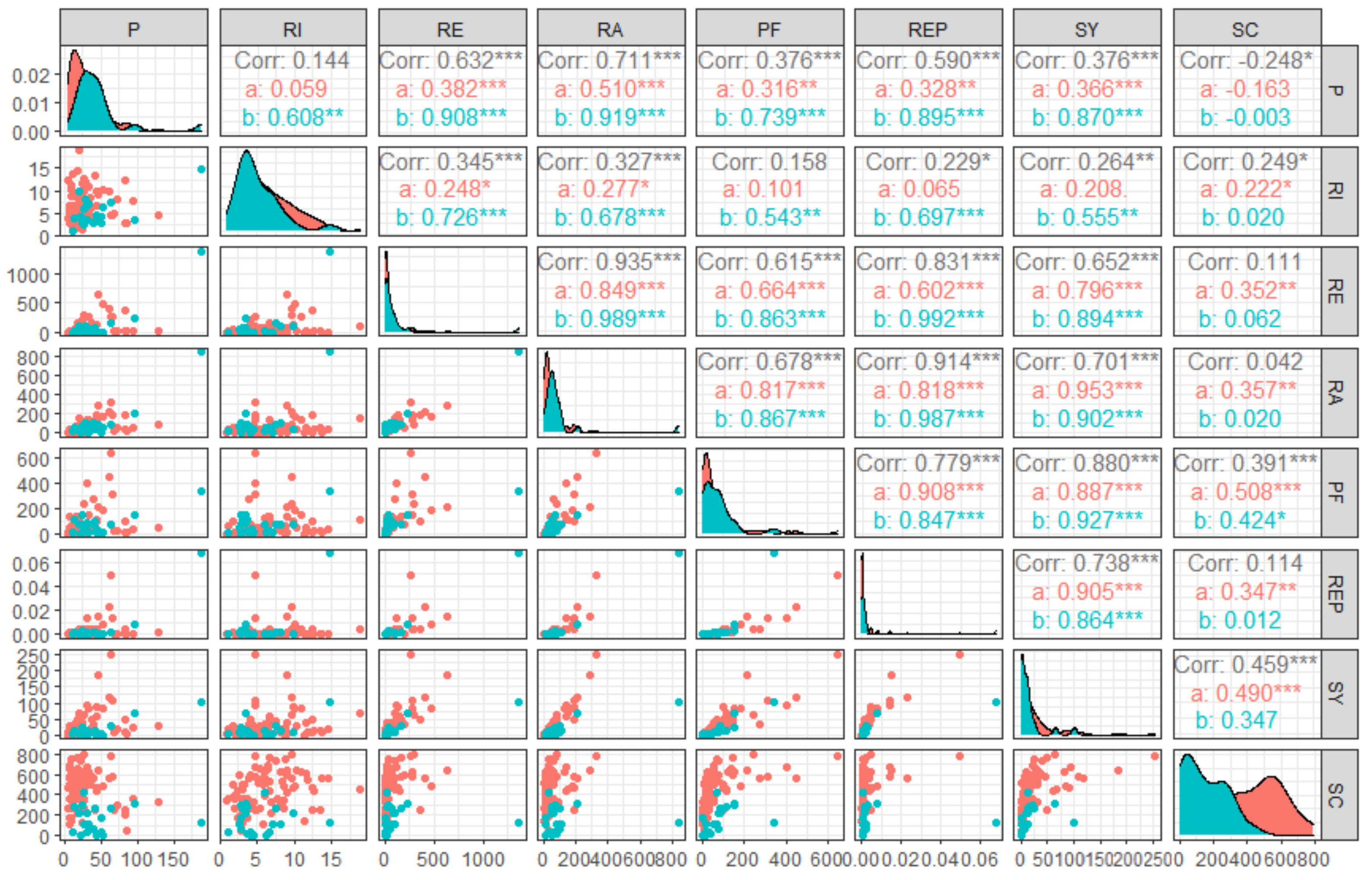

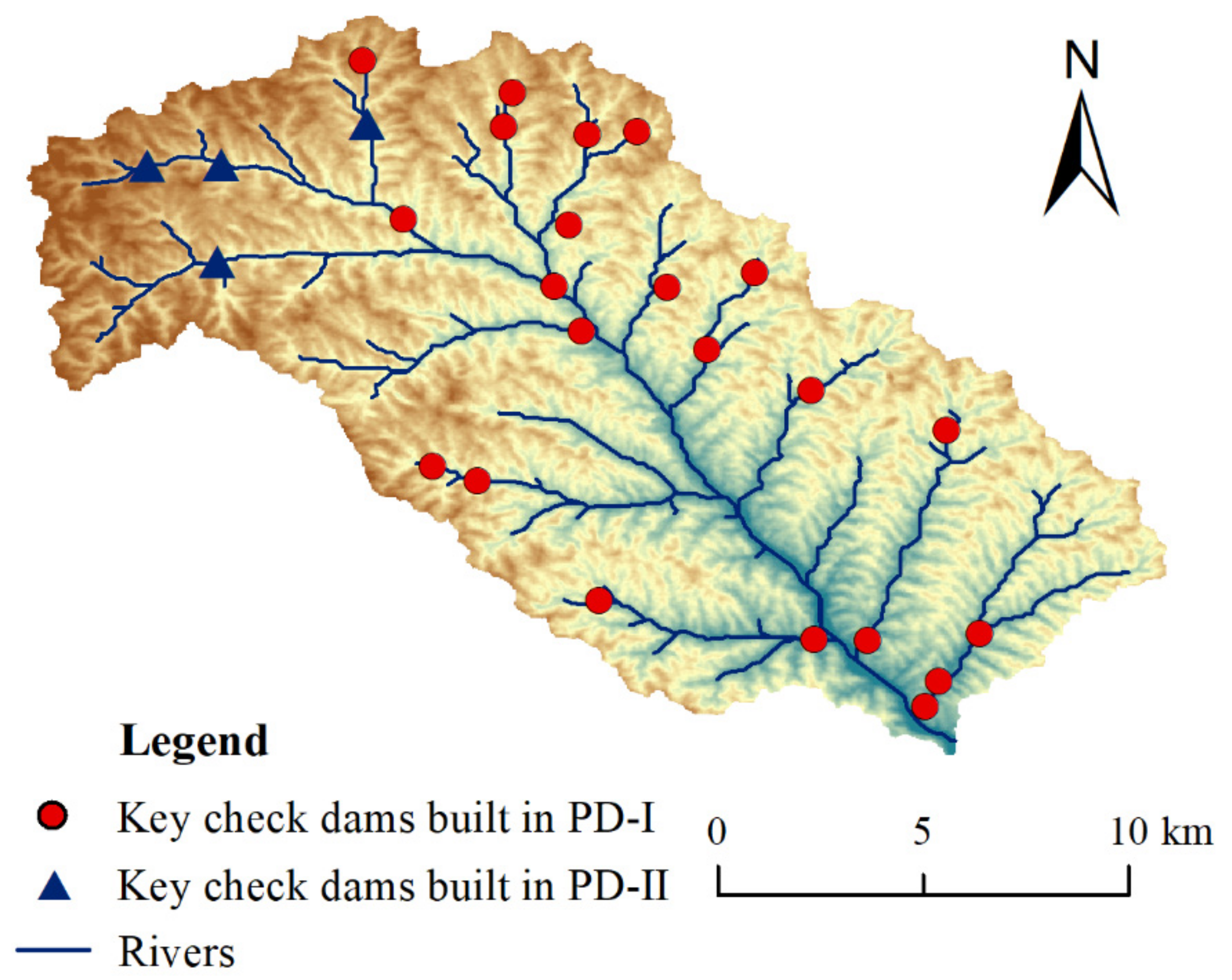
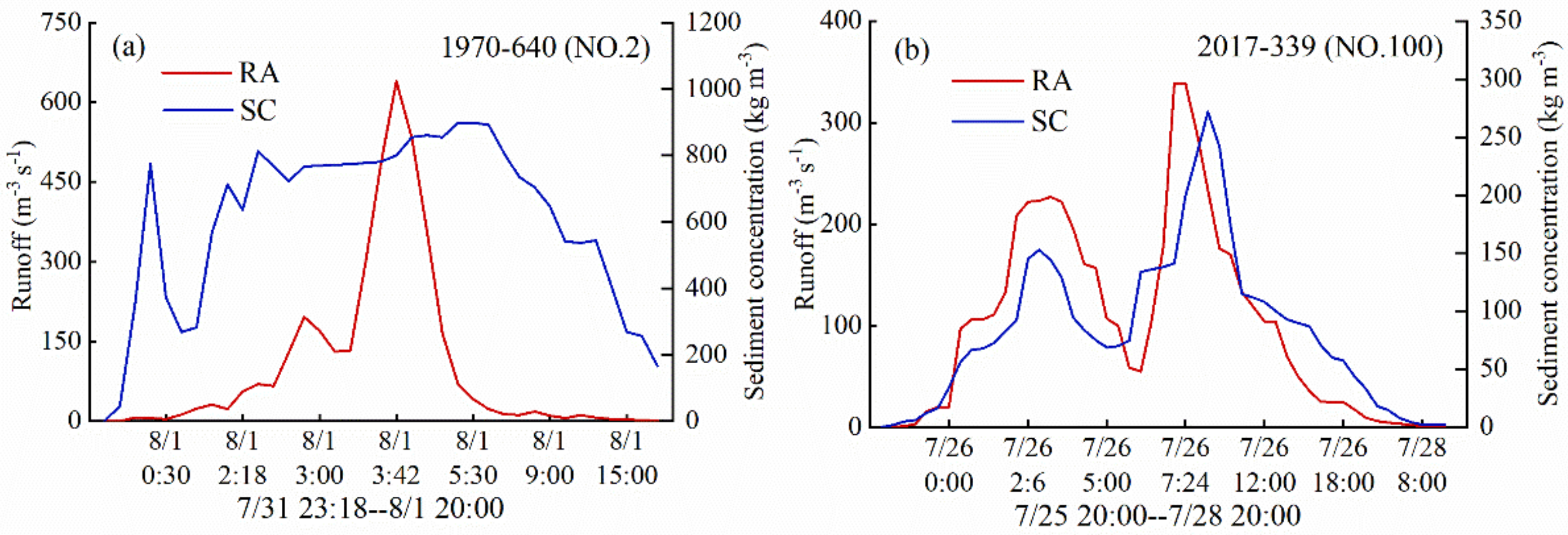
| Statistic Indices | P (mm) | RI (mm h−1) | RA (104 m3) | SY (104 t) | |||||
|---|---|---|---|---|---|---|---|---|---|
| Mean | Maximum | Mean | Maximum | Mean | Maximum | Mean | Maximum | ||
| Period | PD-I | 27.5 | 127.6 | 6.50 | 18.88 | 52.07 | 323.47 | 28.02 | 253.62 |
| PD-II | 44.6 | 187.4 | 5.14 | 14.77 | 96.89 | 837.37 | 14.50 | 101.23 | |
| Change | 17.1 | 59.7 | −1.36 | −4.11 | 44.82 | 513.90 | −13.52 | −152.39 | |
| Change rate (%) | 62.2 | 46.8 | −20.9 | −21.8 | 86.1 | 158.9 | −48.3 | −60.1 | |
| Classification of PF (m3 s−1) | PD-I | PD-II | ||||
|---|---|---|---|---|---|---|
| Frequency of Flood Event (%) | Proportion of SY (%) | Average Sediment Modulus (t km−1) | Frequency of Flood Event (%) | Proportion of SY (%) | Average Sediment Modulus (t km−1) | |
| 5 ≤ PF < 50 | 60.8 | 16.5 | 400 | 45.5 | 10.7 | 50 |
| 50 ≤ PF < 100 | 16.5 | 16.9 | 1400 | 30.4 | 28.1 | 600 |
| 100 ≤ PF < 200 | 13.9 | 27.9 | 2700 | 17.4 | 34.8 | 1400 |
| PF ≥ 200 | 8.9 | 38.8 | 6000 | 4.4 | 30.8 | 5000 |
| Flood Events | P (mm) | RI (mm h−1) | RE (MJ mm ha−1 h−1) | PF (m3 s−1) | FD (h) | Peak SC (kg m−3) |
|---|---|---|---|---|---|---|
| No. 2 | 62.88 | 4.71 | 260.42 | 640 | 20.7 | 898 |
| No. 100 | 187.37 | 14.77 | 1366.93 | 339 | 72 | 272 |
Publisher’s Note: MDPI stays neutral with regard to jurisdictional claims in published maps and institutional affiliations. |
© 2022 by the authors. Licensee MDPI, Basel, Switzerland. This article is an open access article distributed under the terms and conditions of the Creative Commons Attribution (CC BY) license (https://creativecommons.org/licenses/by/4.0/).
Share and Cite
Yang, Q.; Gao, H.; Han, Y.; Li, Z.; Lu, K. Evolution of the Relationship between Runoff and Sediment Transport during Flood Event in the Chabagou Watershed of the Loess Plateau. Sustainability 2022, 14, 11573. https://doi.org/10.3390/su141811573
Yang Q, Gao H, Han Y, Li Z, Lu K. Evolution of the Relationship between Runoff and Sediment Transport during Flood Event in the Chabagou Watershed of the Loess Plateau. Sustainability. 2022; 14(18):11573. https://doi.org/10.3390/su141811573
Chicago/Turabian StyleYang, Qiannan, Haidong Gao, Yong Han, Zhanbin Li, and Kexin Lu. 2022. "Evolution of the Relationship between Runoff and Sediment Transport during Flood Event in the Chabagou Watershed of the Loess Plateau" Sustainability 14, no. 18: 11573. https://doi.org/10.3390/su141811573




